The Variation of Counter-Electrojet Current at the Southeast Asian Sector during Different Solar Activity Levels
Abstract
1. Introduction
2. Materials and Methods
3. Results and Discussion
3.1. CEJ Occurrences Based on Local Times, Solar Activity Levels, and Seasons
3.2. Post Sunset Depletion Occurrence (18:00 LT to 21:00 LT)
4. Conclusions
Author Contributions
Funding
Institutional Review Board Statement
Informed Consent Statement
Data Availability Statement
Acknowledgments
Conflicts of Interest
References
- Chapman, S. The equatorial electrojet as detected from the abnormal electric current distribution about Huancayo, Peru and elsewhere. Arch. Meteorol. Geophys. Bioklimatol. Ser. A Meteorol. Geophys. 1951, 4, 368–390. [Google Scholar] [CrossRef]
- Rifqi, F.N.; Hamid, N.S.A.; Rabiu, A.B.; Yoshikawa, A. Identification of Fractal Properties in Geomagnetic Data of Southeast Asian Region during Various Solar Activity Levels. Universe 2021, 7, 248. [Google Scholar] [CrossRef]
- Gouin, P.; Mayaud, P.N. Apropos de 1’existens possible d’un counter electrojet aux latitudes equatorials. Ann. Gephys. 1967, 23, 41–50. [Google Scholar]
- Hanuise, C.; Mazaudier, C.; Vila, P.; Blanc, M.; Crochet, M. Global dynamo simulation of ionospheric currents and their connection with the equatorial electrojet and counter electrojet: A case study. Journal of Geophysical Research. Am. Geophys. Union 1983, 88, 253–270. [Google Scholar]
- Gurubaran, S. The equatorial counter electrojet: Part of a worldwide current system. Geophys. Res. Lett. 2002, 29, 51-1–51-4. [Google Scholar] [CrossRef]
- Marriott, R.T.; Richmond, A.D.; Venkateswaran, S.V. The quiet-time equatorial electrojet and counter-electrojet. J. Geomagn. Geoelectr. 1979, 31, 311–340. [Google Scholar] [CrossRef]
- Yizengaw, E.; Groves, K.M. Longitudinal and seasonal variability of equatorial ionospheric irregularities and electrodynamics. Space Weather. 2018, 16, 946–968. [Google Scholar] [CrossRef]
- Rabiu, A.B.; Folarin, O.O.; Uozumi, T.; Hamid, N.S.A.; Yoshikawa, A. Longitudinal variation of equatorial electrojet and the occurrence of its counter electrojet. Ann. Geophys. 2017, 35, 535–545. [Google Scholar]
- Rastogi, R.G. Lunar effects in the counter electrojet near the magnetic equator. J. Atmos. Terr. Phys. 1974, 36, 167–170. [Google Scholar] [CrossRef]
- Soares, G.; Yamazaki, Y.; Matzka, J.; Pinheiro, K.; Stolle, C.; Alken, P.; Yoshikawa, A.; Uozumi, T.; Fujimoto, A.; Kulkarni, A. Longitudinal variability of the equatorial counter electrojet during the solar cycle 24. Stud. Geophys. Geod. 2019, 63, 304–319. [Google Scholar] [CrossRef]
- Singh, D.; Gurubaran, S.; He, M. Evidence for the influence of DE3 tide on the occurrence of equatorial counterelectrojet. Geophys. Res. Lett. 2018, 45, 2145–2150. [Google Scholar] [CrossRef]
- Zhou, Y.-L.; Lühr, H.; Xu, H.-W.; Alken, P. Comprehensive analysis of the counter equatorial electrojet: Average properties as deduced from CHAMP observations. J. Geophys. Res. Space Phys. 2018, 123, 5159–5181. [Google Scholar] [CrossRef]
- Rangarajan, G.K.; Rastogi, R.G. Longitudinal difference in magnetic field variations associated with quiet day counter electrojet. J. Geomagn. Geoelectr. 1993, 45, 649–656. [Google Scholar] [CrossRef]
- Kane, R.P.; Trivedi, N.B. Confinement of equatorial counter electrojet to restricted longitudes. J. Geomagn. Geoelectr. 1981, 33, 379–382. [Google Scholar] [CrossRef]
- Francisca, N.O.; Esther, A.H.; Eucharia, C.O.; Isikwue, B.C.; Oby, J.U. Formation and identification of counter electrojet. Int. J. Phys. Sci. 2013, 8, 604–612. [Google Scholar] [CrossRef][Green Version]
- Chandrasekhar, N.P.; Archana, R.K.; Nagarajan, N.; Arora, K. Variability of equatorial counter electrojet signatures in the Indian region. J. Geophys. Res. Space Phys. 2017, 122, 2185–2201. [Google Scholar] [CrossRef]
- Hamid, N.S.A.; Liu, H.; Uozumi, T.; Yumoto, K.; Bhaskara, V.; Akimasa, Y.; Avendaño, S. Relationship between the equatorial electrojet and global Sq currents at the dip equator region. Earth Planets Space 2014, 66, 146. [Google Scholar] [CrossRef]
- Hamid, N.S.A.; Rosli, N.I.M.; Ismail, W.N.I.; Yoshikawa, A. Effects of solar activity on ionospheric current system in the Southeast Asia region. Indian J. Phys. 2021, 95, 543–550. [Google Scholar] [CrossRef]
- Alex, S.; Mukherjee, S. Local time dependence of the equatorial counter electrojet effect in a narrow longitudinal belt. Earth Planets Space 2001, 53, 1151–1161. [Google Scholar] [CrossRef]
- Uozumi, T.; Yumoto, K.; Kitamura, K.; Abe, S.; Kakinami, Y.; Shinohara, M.; Yoshikawa, A.; Kawano, H.; Ueno, T.; Tokunaga, T.; et al. A new index to monitor temporal and long–term variations of the Equatorial Electrojet by MAGDAS/CPMN real–time data: EE–Index. Earth Planets Space 2008, 60, 785–790. [Google Scholar] [CrossRef]
- Hamid, N.S.A.; Liu, H.; Uozumi, T.; Yumoto, K. Equatorial electrojet dependence on solar activity in the Southeast Asia sector. Antarct. Rec. 2013, 57, 329–337. [Google Scholar]
- Soares, G.; Yamazaki, Y.; Matzka, J.; Pinheiro, K.; Morschhauser, A.; Stolle, C.; Alken, P. Equatorial counter electrojet longitudinal and seasonal variability in the American sector. Am. Geophys. Union 2018, 123, 9906–9920. [Google Scholar] [CrossRef]
- Ismail, W.N.I.; Hamid, N.S.A.; Abdullah, M.; Yoshikawa, A.; Uozumi, T.; Radzi, Z.M. Comparison of EEJ Longitudinal Variation from Satellite and Ground Measurements over Different Solar Activity Levels. Universe 2021, 7, 23. [Google Scholar] [CrossRef]
- Rastogi, R.G. Westward equatorial electrojet during daytime hours. J. Geophys. Res. 1974, 79, 1503–1512. [Google Scholar] [CrossRef]
- Onwumechili, C.A. The Equatorial Electrojet; Gordon and Breach: Newark, NJ, USA, 1997. [Google Scholar]
- Rastogi, R.G.; Yumoto, K. Equatorial electrojet in the East Brazil anomaly region. Earth Planets Space 2006, 58, 103–106. [Google Scholar]
- Ramkumar, T.K.; Gurubaran, S.; Rajaram, R. Lower E-region MF radar spaced antenna measurements over magnetic equator. J. Atmos. Sol. Terr. Phys. 2002, 64, 1445–1453. [Google Scholar] [CrossRef]
- Somayajulu, V.V. Behaviour of harmonic components of the geomagnetic field during counter electrojet events. J. Geomagn. Geoelectr. 1988, 40, 111–130. [Google Scholar] [CrossRef]
- Sridharan, S.; Gurubaran, S.; Rajaram, R. Structural changes in the tidal components in the mesospheric winds as observed by the MF radar during afternoon counter electrojet events. J. Atmos. Sol. Terr. Phys. 2002, 64, 1455–1463. [Google Scholar] [CrossRef]
- Manju, G.; Viswanathan, K.S. VHF radar studies of counter electrojet events during the northern winter solstice period of 1992. Earth Planets Space 2007, 59, 259–265. [Google Scholar] [CrossRef][Green Version]
- Denardini, C.M.; Abdu, M.A.; Aveiro, H.C.; Resende, L.C.A.; Almeida, P.D.S.C.; Olívio, Ê.P.A.; Sobral, J.H.A.; Wrasse, C.M. Counter electrojet features in the Brazilian sector: Simultaneous observation by radar, digital sounder and magnetometers. Ann. Geophys. 2009, 27, 1593–1603. [Google Scholar] [CrossRef]
- Sarudin, I.; Hamid, N.S.A.; Abdullah, M.; Buhari, S.M.; Shiokawa, K.; Otsuka, Y.; Yatini, C.Y. Equatorial plasma bubble zonal drift velocity variations in response to season, local time, and solar activity across Southeast Asia. J. Geophys. Res. Space Phys. 2020, 125, e2019JA027521. [Google Scholar] [CrossRef]
- Sarudin, I.; A Hamid, N.S.; Abdullah, M.; Buhari, S.M.; Shiokawa, K.; Otsuka, Y.; Hozumi, K.; Jamjareegulgarn, P. Influence of zonal wind velocity variation on equatorial plasma bubble occurrences over Southeast Asia. J. Geophys. Res. Space Phys. 2021, 126, e2020JA028994. [Google Scholar] [CrossRef]
- Marriott, R.T.; Schieldge, J.P.; Venkateswaran, S.V.; Cain, J.C. The quiet-time equatorial counter electrojet. In Proceedings of the Second General Scientific Assembly of IAGA, Kyoto, Japan, 1 September 1973. [Google Scholar]
- Mayaud, P.N. The equatorial counter-electrojet—A review of its geomagnetic aspects. J. Atmos. Sol. Terr. Phys. 1977, 39, 1055–1070. [Google Scholar] [CrossRef]
- Uemoto, J.; Maruyama, T.; Saito, S.; Ishii, M.; Yoshimura, R. Relationships between pre-sunset electrojet strength, pre-reversal enhancement and equatorial spread-F onset. Ann. Geophys 2010, 28, 449–454. [Google Scholar] [CrossRef]
- Akiyama, T.; Yoshikawa, A.; Fujimoto, A.; Uozumi, T. Relationship between plasma bubble and ionospheric current, equatorial electrojet, and equatorial counter electrojet. J. Phys. Conf. Ser. 2018, 1152, 012022. [Google Scholar] [CrossRef]
- Abadi, P.; Otsuka, Y.; Liu, H.X.; Hozumi, K.; Martinigrum, D.R.; Jamjareegulgarn, P.; Thanh, L.T.; Otadoy, R. Roles of thermospheric neutral wind and equatorial electrojet in pre-reversal enhancement, deduced from observations in Southeast Asia. Earth Planet. Phys. 2021, 5, 387–396. [Google Scholar] [CrossRef]


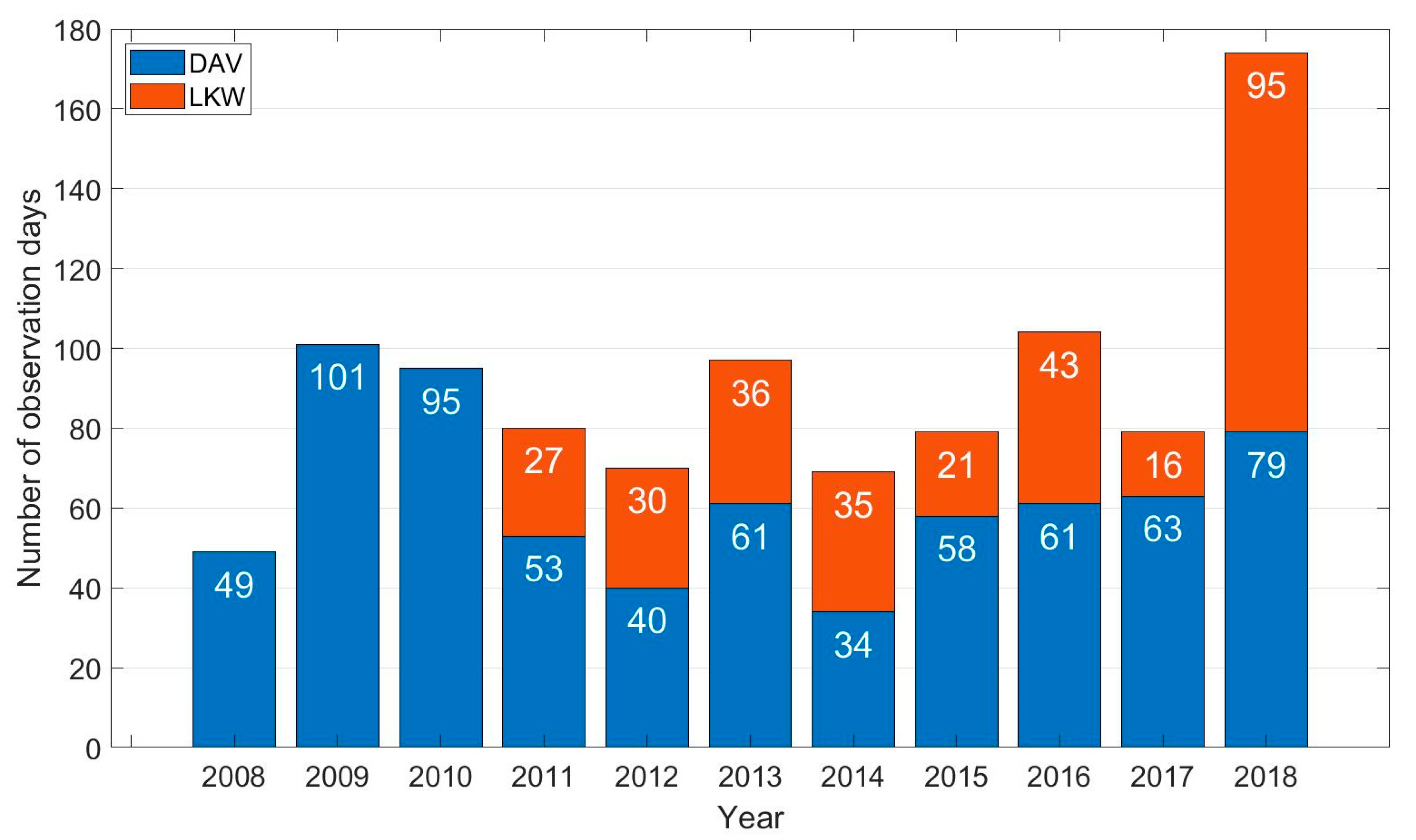


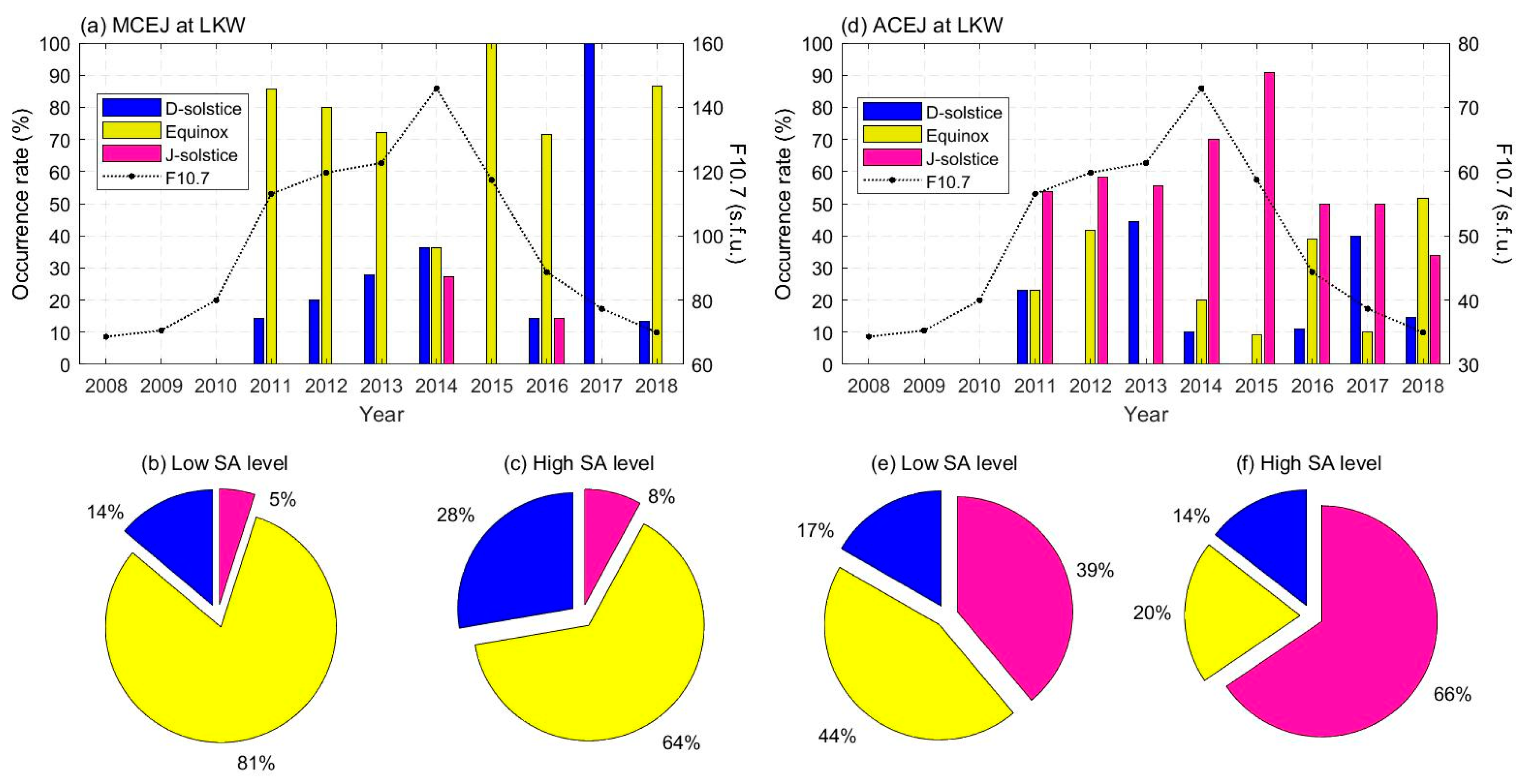
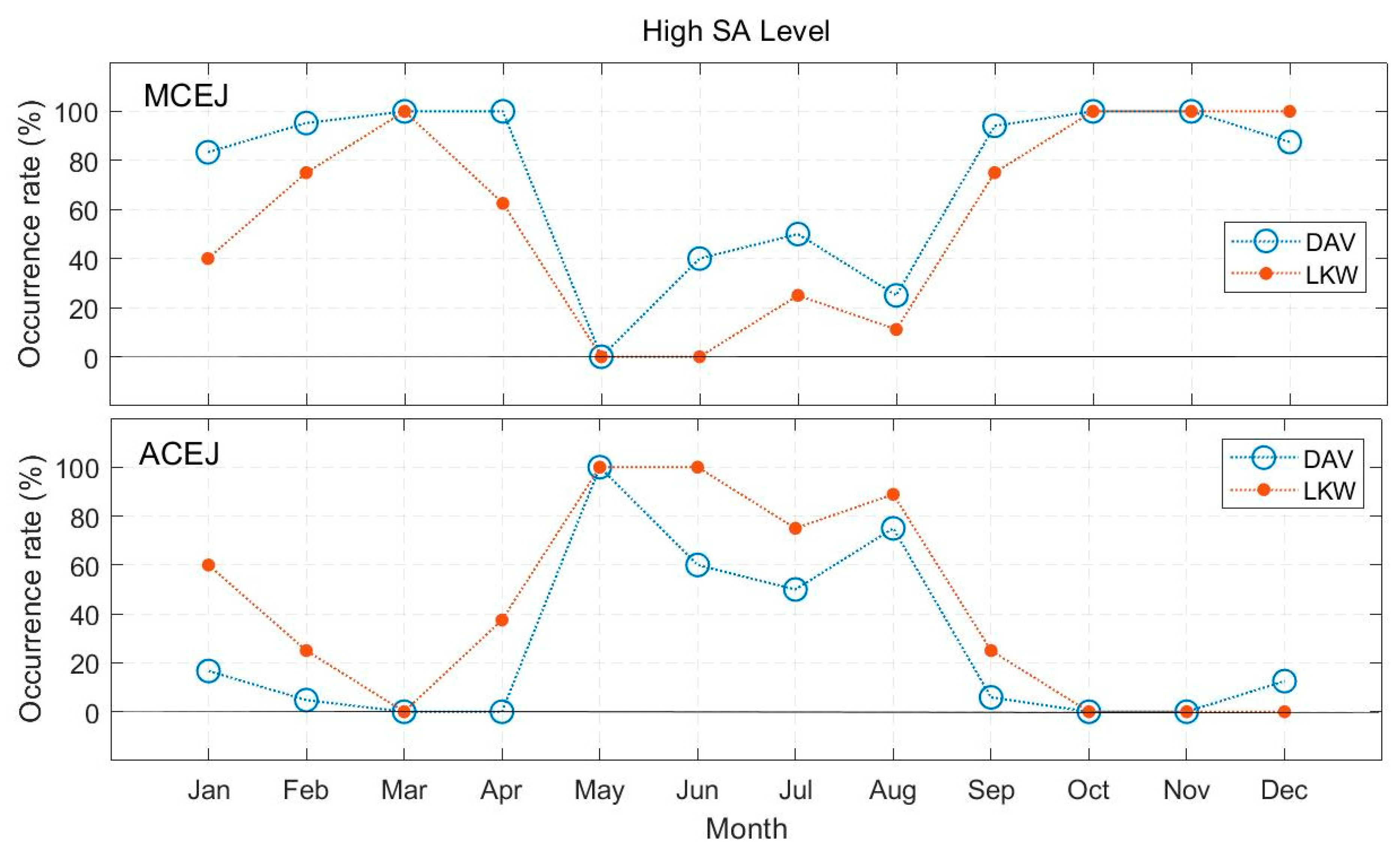
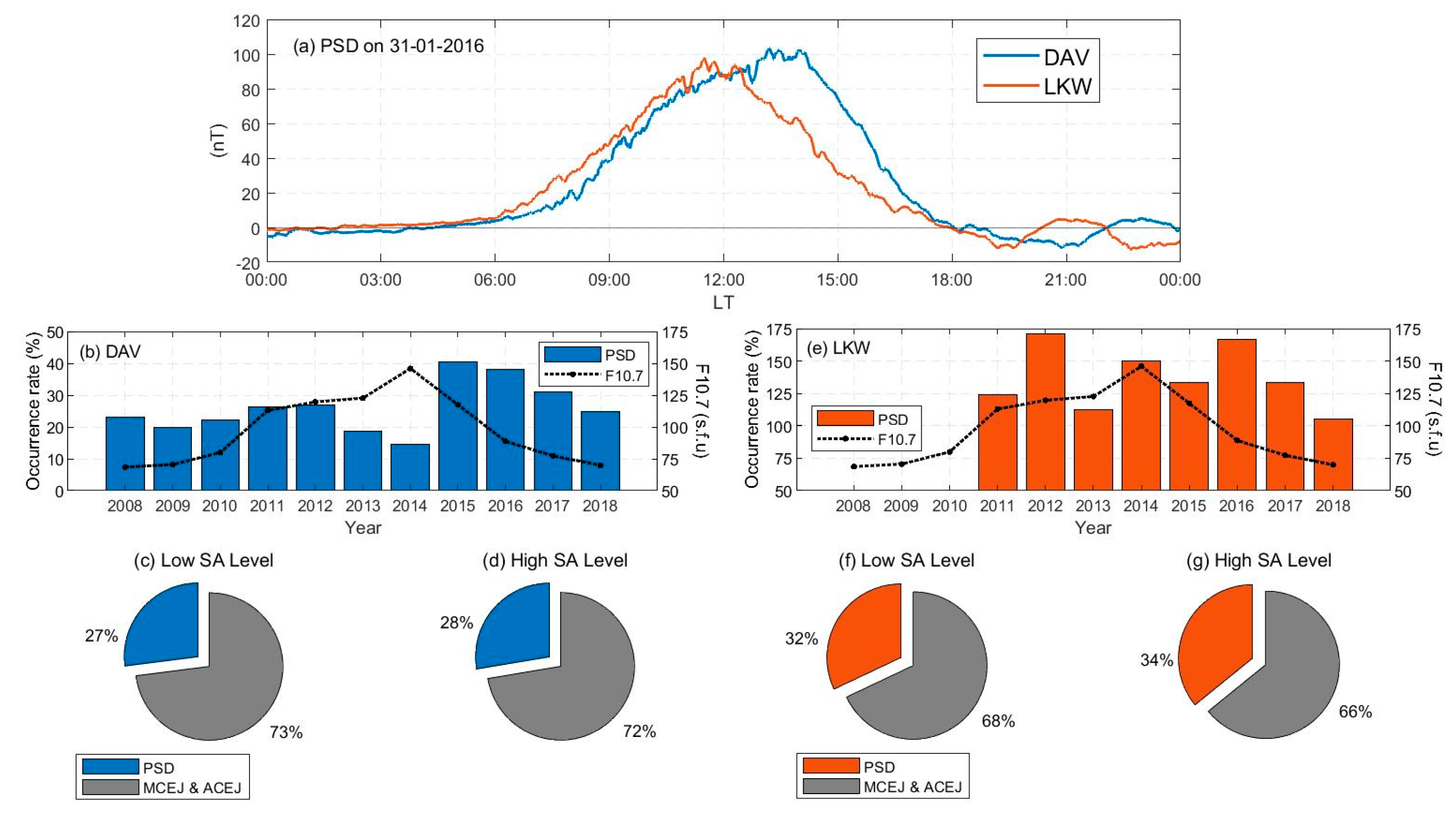
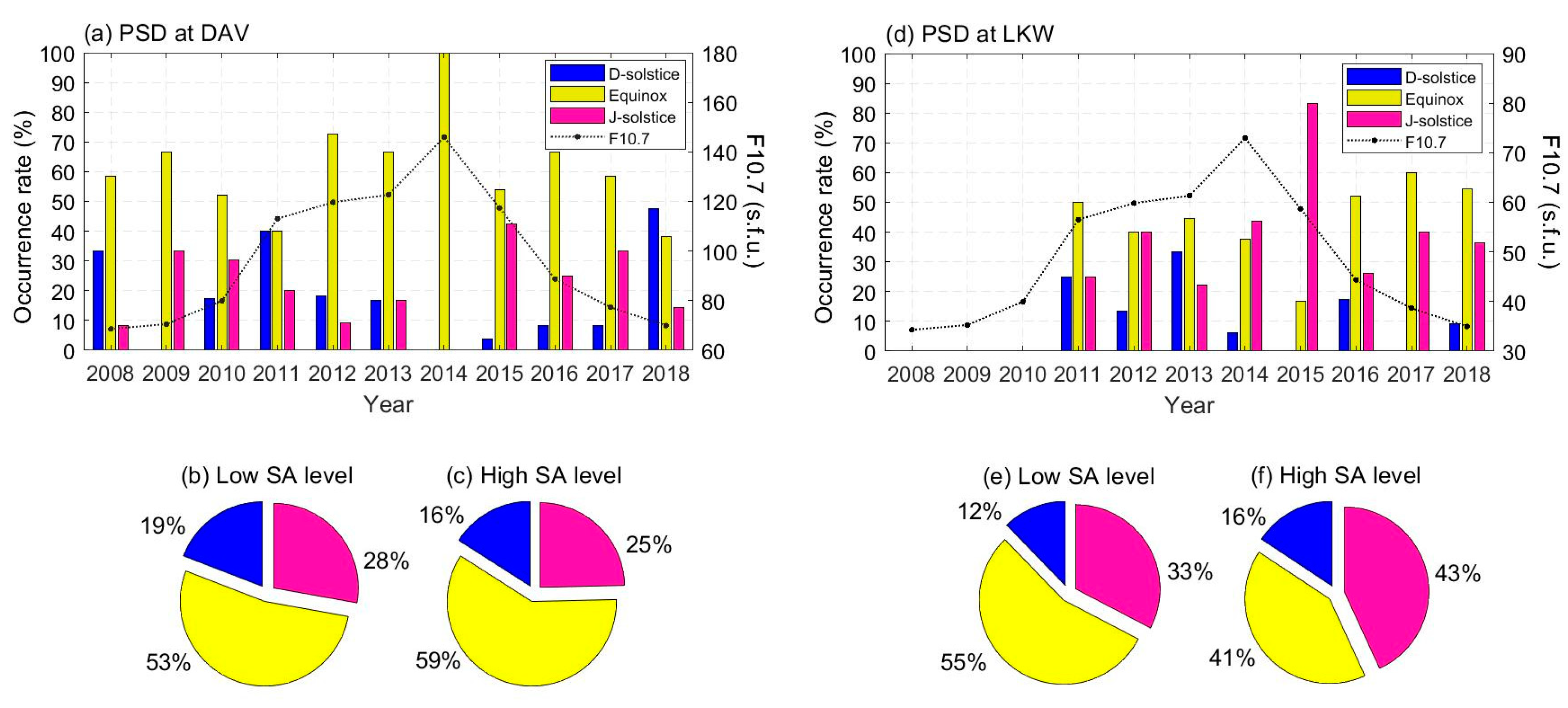
Publisher’s Note: MDPI stays neutral with regard to jurisdictional claims in published maps and institutional affiliations. |
© 2022 by the authors. Licensee MDPI, Basel, Switzerland. This article is an open access article distributed under the terms and conditions of the Creative Commons Attribution (CC BY) license (https://creativecommons.org/licenses/by/4.0/).
Share and Cite
Mohd Rosli, N.I.; Abdul Hamid, N.S.; Abdullah, M.; Yusof, K.A.; Yoshikawa, A.; Uozumi, T.; Rabiu, B. The Variation of Counter-Electrojet Current at the Southeast Asian Sector during Different Solar Activity Levels. Appl. Sci. 2022, 12, 7138. https://doi.org/10.3390/app12147138
Mohd Rosli NI, Abdul Hamid NS, Abdullah M, Yusof KA, Yoshikawa A, Uozumi T, Rabiu B. The Variation of Counter-Electrojet Current at the Southeast Asian Sector during Different Solar Activity Levels. Applied Sciences. 2022; 12(14):7138. https://doi.org/10.3390/app12147138
Chicago/Turabian StyleMohd Rosli, Nur Izzati, Nurul Shazana Abdul Hamid, Mardina Abdullah, Khairul Adib Yusof, Akimasa Yoshikawa, Teiji Uozumi, and Babatunde Rabiu. 2022. "The Variation of Counter-Electrojet Current at the Southeast Asian Sector during Different Solar Activity Levels" Applied Sciences 12, no. 14: 7138. https://doi.org/10.3390/app12147138
APA StyleMohd Rosli, N. I., Abdul Hamid, N. S., Abdullah, M., Yusof, K. A., Yoshikawa, A., Uozumi, T., & Rabiu, B. (2022). The Variation of Counter-Electrojet Current at the Southeast Asian Sector during Different Solar Activity Levels. Applied Sciences, 12(14), 7138. https://doi.org/10.3390/app12147138







